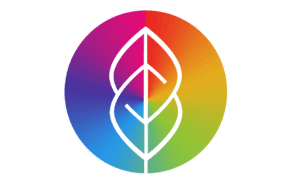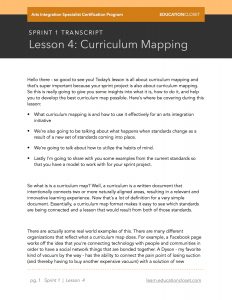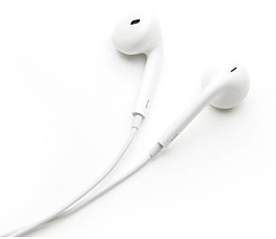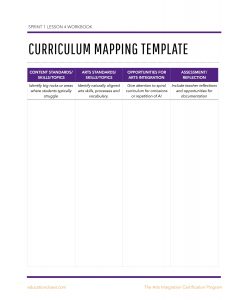SPRINT 1, LESSON 4
Curriculum Mapping Process
Video play time: 14:40
A curriculum map is a written document that intentionally connects two or more naturally aligned areas, resulting in a relevant and innovative learning experience. In this lesson, you’ll get some insights into what it is, how to do it, and help you to develop the best curriculum map possible. Here’s where be covering during this lesson:
- What curriculum mapping is and how to use it effectively for an arts integration initiative
- We’re also going to be talking about what happens when standards change as a result of a new set of standards coming into place.
- We’re going to talk about how to utilize the habits of mind.
- Lastly I’m going to share with you some examples from the current standards so that you have a model to work with for your sprint project.





Whew…. talk about shaking out the cobwebs….lol! I do enjoy Standards, Content Area, Visual Arts, Mapping…. and the challenges of aligning and creating lessons… but talk about Summer buzz kill… hahaha. Thank goodness you prepped us with lesson 2 and 3 with vocabulary and standards. Both opened up my thoughts to the curriculum map process. I must admit…I usually work Art skills and process first then fit to Standards, opps. Working with children, I try to think of what will engage them first. Habits of Mind…was also new to me… and I’ll be creating posters from your info. Thank you. The curriculum map I choose was for 2nd g. ELA and Art…writing Standard #3 and VA.RE.8.1.2a…. students interpret a story in writing and Art students interpret an artwork in discussion …. Working in pairs they create an artwork with mood & feeling of anziano event in their life, and write poem based on their artwork….strategy:See think wonder… inspiration Tar Beach by Faith Reingold. Hope it aligns well.
I like the poster idea – even for me. I think that will be a NEEDED tool when I start to engage other educators in this process.I haven’t chosen a curriculum map, yet. I think I need to sit with this all for a while AND give it another pass before I take action. Thanks for sharing.
Haha! That’s my new title: Summer Buzzkill. :) I really like your alignments – that could be fascinating to see come together!
I’m in the same boat as far as doing things backward! I think it’s easy as an art teacher to try to start with skills and techniques because we have so many ideas in our heads. I definitely needed this reminder to start with the standards first.
This was, as usual, a good lesson. I appreciate the explanation of why and how to use a curriculum map and why it is valuable. I agree that having a written document is important to help keep everyone on track, but does allow for creativity. The Habits of Mind is a totally new term to me. I see how they are a great connecting point to other area standards. I appreciate that you mentioned that we need to be considerate and differentiate instruction/collaboration with other teachers. We/I think about the for students, but I really hadn’t thought about how important that would be for teacher to teacher work – good to remember. The other term that was introduced that I really liked and will appropriate is “elegant fit.” As I’m a music person by trade, I was going to try to build my curriculum map in my content. As I do work with all Arts in my current position, I think I might try Drama or Dance. (I’m not sure.) I am married to science because of the focus of my grant, so I think I might need to look for standards that align better, or in a more understandable manner. All this is kind of thinking out loud, but that’s where I am at the end of this lesson.
These are all great thoughts Karen! Definitely beginning with your “home base” (music) is a great start because of sheer comprehension. But be sure to venture out. Once you get the “hang of it” with music really push yourself into the other arts areas, that is what will make you a strong specialist!
I want to layer in with intention social-emotional pillars into my map. The question is would that be included in the introduction or in each line of the map itself. So many of the lesson seeds include collaboration, problem-solving, making decisions, and a plethora of other SEL skills. I feel that they need to be included, taught and assessed as a part of the arts integration approach. One of the barriers for teachers with the approach, in my experience, is expecting scholars to be successful in group work and collaboration without any direct instruction and feedback on those skills. What I want to do is to add a column for the natural connection of SEL/collaborative skills to my map to be sure that they are given the same weight as the content and arts. Thoughts???
Laura – I’m blown away right now. This is amazing! YES – go for it. I am really excited to see where this takes you.
Hi there! Last night I was so discouraged! But I decided to keep plugging away and today I feel so much better. After watching the lesson, I immediately had all sorts of ideas swirling in my head. I just had to go find the standards to match my ideas. My first was an ELA/Art integration. When I was teaching 4th grade the hardest thing for my students to do was inference. So, I wanted to start there (CCSS, grade 4 Reading key idea 1) and connect it with VA Re7.2.4a and VA Re8.1.4a. VA Re7.2.4a asks students to analyze components in visual imagery that convey meaning. VA Re8.1.4a asks students to interpret art by referring to contextual information and analyzing relevant subject matter, characteristics of form and use of media. Classroom teacher works on close reading and inferring. Art teacher works on close observation of an art image, using the See, Wonder, Think strategy and then ask students to draw conclusions, supported by evidence from the image. Assessment for the lessons can be a choice for the students. Choice one would be to create an illustration to go along with the reading passage being sure to include enough details in their are to accurately portray the story. Choice two would allow the students to write a story to go along with the art image with enough detail, one could visualize what was happening.
I hope I am on the right track. I feel a little anxious because I am so far behind.
Kimberly – this is SO GOOD. You are definitely on the right track! This would be a good alignment for your curriculum map project. Use that visual art standard and your reading standard for your alignments and include your idea in the “lesson seed” column.
Also…here’s a similar lesson (not the same standards, but a sample) that may help you think of even more alignments: https://educationcloset.com/2012/10/26/reading-the-art-lesson/
Lastly, PLEASE give yourself some grace. This is about progress, not perfection. You’re not behind – you’re exactly where you need to be. We have a month before the project is due, so you’ve got time. And this process can be uncomfortable because it forces us to stretch. I’m so proud of you for plugging away and committing to moving forward. You’ve GOT this!!
Looking at the habits of mind, some things jumped out at me as an art educator:
Science: Openness to new ideas, imagination and creativity, create a hypothesis( draft of art), test hypothesis ) try out you idea), draw conclusion (reflect on effectiveness).
Mathematics: Persevere (kids give up if its not easy), use tools strategically (pick the right media).
Engineering: Communication and collaboration (great for bouncing ideas and seeing multiple solutions to problem in art and beyond)
Kimberly!!! Why do I totally want to make a poster of this!! These are such great pillars to those subjects…AND are literally the pillers of the arts!!
The curriculum map is a way to reflect on your teaching practices. This provides thoughtful planning are essential to effective educational experiences, building block for partnering with school(s), classroom teachers and music/art specialist. Habits of Mind-Engineer goes well with how I teach. I understand…
Yes Cheryl! These maps are also such a great starting point for integration! They are usually not too in depth, and can be accomplished in a day or two so it really allows people to dip their toes in, so to speak. When we start implementing this in our schools/districts we can’t make it happen overnight, so these are great seeds to start playing with to get comfortable.
I am looking forward to putting together this project. It has taken me a little time to get my thoughts together and not to over think everything. My greatest challenge is picking the standards I would like to work with.
Thank goodness for this! I think I can use some stuff I have, but 8-10 each is going to be a lot for how many grades I teach. Goodness Gracious
Hey There! You only need 8-10 total, not for each grade that you teach, so you can mix and match the grades :)